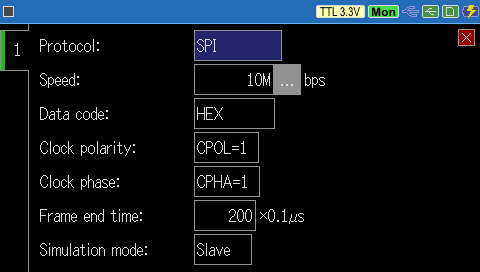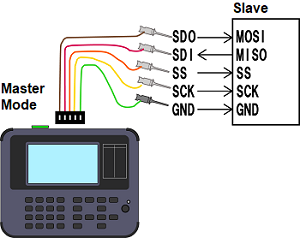OP-FW10XR
OP-FW10XR is an extension firmware which accelerates the measurement test speed of protocol analyzer LE-3500XR for bit synchronous communication (HDLC/SDLC/X.25 and CC-Link communication) and SPI communication up to 10Mbps. By processing all major measurement processing with FPGA, communication data can be reliably captured with a time stamp in microseconds.
It is the best option for monitoring high-speed HDLC communication such as CC-LINK of RS-485 multi-drop method and analyzing high-speed HDLC or high-speed SPI communication of TTL signal level on the printed circuit board.
Applicable analyzers: LE-3500XR(V2), LE-3500XR(V2) with OP-SB5GL, LE-3500XR, LE-3500XR with OP-SB5GL
Higher communication speed for monitoring test
With standard firmware the supported maximum speed is 2.048 Mbps but with this firmware the speed is extended much higher. It can support CC-LINK, which uses high-speed HDLC frames such as 10Mbps and 5Mbps. Of course, you can test by setting any communication speed with 4 significant digits up to the maximum speed.
HDLC (half duplex)>>>Max.10MbpsHDLC (full duplex)>>>Max.5Mbps
SPI>>>Max.10Mbps*
Supports HDLC without clock line
Accurate real-time monitoring and simulation of bit synchronous communication such as NRZ and NRZI encoding HDLC, SDLC, and CC-LINK is available. Since the transmission/reception clock can be extracted from the data line and bit-synchronized, it also supports HDLC and CC-LINK, which often use RS-485 lines without transmission/reception clock lines.
< HDLC/SDLC settind display >

< RS-422 (full duplex) HDLC display >

< RS-485 (half duplex) HDLC display >

< RS-485 (half duplex) HDLC damp display >

Supports 4 patterns of clock mode of SPI
Real-time monitoring and simulation of SPI is available. All four SPI transfer timings are supported by combining clock polarity and clock phase. Even in the case of SPI devices that transfer all frames while the SS signal remains at low level, by setting the frame end time (transfer clock pause time 0.1 µ seconds unit), data can be divided in time units such that of the CPU intervenes, and the relationship between transfer commands and data can be analyzed efficiently.
< SPI setting display >

< SPI monitor display >

< SPI timing of clock and data >

< SPI monitor connection >

< SPI master simulation >

< SPI slave simulation >

A high-precision time stamp which can be recorded in units of minimum 1 µsec allows you to investigate the reception timing in detail.
< SPI monitor line break display >

< Differential time stamp display >

Extended HDLC address filter
In the standard firmware, only the filter for the 1st byte data after the start flag is available. By using this firmware, it becomes possible to specify a path filter with a bit mask for the first byte and second byte data following the start flag. By this you can flexibly monitor only the communication frame that you want to focus on at HDLC or CC-LINK.
< HDLC filter setting display >

Sorted display for easy viewing of half-duplex communication frames
In RS-485 half-duplex communication, the communication frames of multiple nodes flow in a pair of communication cables in a time division manner. When this communication line is connected to the TXD side of the analyzer and monitored, all communication frames are displayed only on the TXD side, so it may be difficult to analyze the data of the communication node you want to focus on.
With this firmware, communication frames that match the TXD pass filter are displayed on the TXD side, unmatched communication frames are displayed on the RXD side, and only communication frames that match the TXD and RXD pass filters are displayed on each line.

Sequential trigger of transmitted/received data string is available
The monitor operation can be automatically stopped by detecting a specific character string, communication error (CRC error, abort, short frame), or change in external trigger signal. Since not only it can detext the character strings in the communication frame independently but also can detect two sets of character strings sequentially, triggers that follow the communication procedure are available. In addition, when the trigger matches, the external trigger terminal is changed to notify it, so it can execute testing in cooperation with an external measuring instrument.
< Trigger setting display >

< Trigger setting display >

Supports long-term recording on a storage device
Even if the measured line speed is 10Mbps, if the average throughput including idle time is less than 1 Mbps, you can use the auto save function to continuously record the data to the USB memory or SDHC card without losing the communication log. Also, like the standard firmware, it supports the automatic measurement (auto-run) function and search function.
Remote measurement by PC link software is also available
Text/CSV conversion of measurement data and remote measurement by PC link software "LE-PC300R" is available.
< HDLC text conversion example >

< SPI CSV conversion example >

Easy firmware switching
Once installed to the analyzer, you can easily switch between standard firmware and extended firmware.
Standard firmware: Press [SHIFT] + [0] when turning on the power.

High-speed firmware: Press [SHIFT] + [3] when turning on the power.
